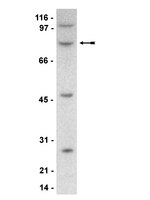CIN85 associates with endosomal membrane and binds phosphatidic acid.
Jing Zhang, Xiudan Zheng, Xiao Yang, Kan Liao, Jing Zhang, Xiudan Zheng, Xiao Yang, Kan Liao
Cell research
19
733-46
2009
Show Abstract
CIN85 (Cbl-interacting protein of 85 kDa) is an important molecule involved in receptor tyrosine kinase endocytosis. Here we report that through its positively charged C-terminus, CIN85 associates with a fusogenic lipid - phosphatidic acid. Its coiled-coil domain plays an important role in mediating this protein-lipid interaction. Deletion of the coiled-coil domain results in loss of membrane association, and reduced interaction with c-cbl, finally causing the blockage of epidermal growth factor receptor downregulation. In addition, a significant portion of CIN85 is located on the endosomal compartment and is related to endocytic cargo sorting, characterized by CIN85's localization on the "E class" compartment and EGF degradation blockage in CIN85 knockdown cells. Taken together, our results suggest that CIN85 may function as a scaffold molecule in both the internalization and endocytic cargo sorting processes through its association with the endosomal membrane. | | 19417776
 |
Studying protein isoforms of the adaptor SETA/CIN85/Ruk with monoclonal antibodies.
Finniss, Susan, et al.
Biochem. Biophys. Res. Commun., 325: 174-82 (2004)
2004
Show Abstract
SETA/CIN85/Ruk is a multifunctional adaptor protein involved in signal transduction and attenuation downstream of receptor tyrosine kinases. It has a modular structure, and various isoforms that combine different protein-protein interaction domains have been proposed based on cDNA analysis. As a first step towards understanding SETA/CIN85/Ruk isoforms at the protein level, we have characterized 5 monoclonal antibodies against this protein. Three of these were used to study lysates fractionated on a pH gradient, leading to the identification of various SETA/CIN85/Ruk proteins on the basis of pI and apparent molecular weight. While good correspondence with proteins predicted from cDNA analysis was found for two isoforms, in most cases it was not possible to make an unequivocal assignment. We conclude that additional splice variants remain to be described, and that a deeper understanding of SETA/CIN85/Ruk post-translational processing and modification is necessary to gain further understanding of this complex gene product. | Immunoblotting (Western) | 15522216
 |
The glioma-associated protein SETA interacts with AIP1/Alix and ALG-2 and modulates apoptosis in astrocytes.
Chen, B, et al.
J. Biol. Chem., 275: 19275-81 (2000)
2000
Show Abstract
Expression of the src homology 3 (SH3) domain-containing expressed in tumorigenic astrocytes (SETA) gene is associated with the tumorigenic state in astrocytes. SETA encodes a variety of adapter proteins containing either one or two SH3 domains, as suggested by the sequence heterogeneity of isolated cDNAs. Using both SH3 domains in a yeast two-hybrid screen of a glial progenitor cell cDNA library, we isolated the rat homolog of the ALG-2-interacting protein 1 or ALG-2-interacting protein X (AIP1/Alix). In vitro confrontation experiments showed that the SH3-N domain of SETA interacted with the proline-rich C terminus of AIP1. In co-immunoprecipitation experiments, SETA and AIP1 interacted and could form a complex with apoptosis-linked gene 2 protein. Endogenous SETA and AIP1 proteins showed similar patterns of staining in primary rat astrocytes. Misexpression of a variety of SETA protein isoforms in these astrocytes revealed that they localized to the actin cytoskeleton. Furthermore, SETA proteins containing the SH3-N domain were able to sensitize astrocytes to apoptosis induced by UV irradiation. Expression of the isolated SH3-N domain had the greatest effect in these experiments, indicating that interference in the interaction between endogenous SETA and AIP1 sensitizes astrocytes to apoptosis in response to DNA damage. | | 10858458
 |











